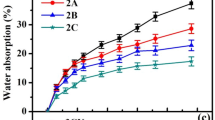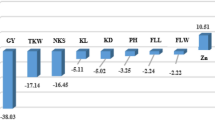Abstract
The objective of the study is to investigate the biological effects of N+ beam implantation in different ploidy rice. N+ beam implantation had increase effect in tillers number, spikelet fertility, grain yield per plant, si-phellem cell size, photosynthetic rate, transpiration rate, flag leaf dry weight, flag leaf culm dry weight, stomatal length, vascular bundle area, and protein and starch content and decrease effect in 1,000-grain weight, stomatal width and chlorophyll, calcium, sodium, and zinc content for all rice lines. N+ beam implantation had opposite effect on diploid and autotetraploid rice lines in vascular bundle area, stomatal complexes areas, epidermal cell size, era length, area of air spaces, midrib length, papilla number, flag leaf length, flag leaf width, flag leaf area, and cadmium, copper, ferrum, magnesium and phosphorus content. Twenty traits of diploid line and ten traits of autotetraploid line are significantly increased by N+ beam in this experiment, ranging from 6.8 to 362.7 % in diploid line and 7.9 to 131.7 % in autotetraploid line. Six traits of diploid lines and 15 traits of autotetraploid line are significantly decreased by N+ beam implantation in this experiment, ranging from 8.9 to 87.4 % in diploid line and 5.6 to 88.5 % in autotetraploid line.
Similar content being viewed by others
Abbreviations
- (4) :
-
Autotetraploid rice line
- (2) :
-
Diploid rice line
References
Association of Official Analytical Chemists (AOAC). (1995). Association of Official Analytical Chemists official method of analysis, 16th edn [M]. Method 990.03 (pp. 35–43). Washington, DC: The Association.
Bao, W. K., & Yan, Y. R. (1956). A preliminary report on investigations of autopolyploids and amphidiploid in some cereal crops. Acta Botanica, 5, 297–316.
Cai, D. T., Chen, J. G., Chen, D. L., et al. (2005). Exploring new way to solve the potential crisis of food shortage by polyploid rice. In: 5th International Rice Genetics Symposium. 19–23 Nov. Manila, Philippines. IRRI, p. 58.
Cai, D. T., Chen, J. G., Chen, D. L., et al. (2007). The breeding of two polyploid rice lines with the characteristic of polyploid meiosis stability. Science in China. Series C, Life Sciences, 37(2), 217–226 (in Chinese).
Chang, J. H., Luo, Y. W., & Wang, B. Y. (1999). Study on the uses and improvements of autotetraploid sorghum. Acta Agriculture Boxeali Sinica, 1, 89–93.
Chen, Z. J. (2010). Molecular mechanisms of polyploidy and hybrid vigor. Trends in Plant Science, 15, 57–71.
Chesnokov, Y. V., & Manteuffel, R. (2000). Dose effect of UV-B irradiation on pollen tube growth and seed-specific promoter activities in irradiated pollen grains of Nicotiana plumbaginifolia. Sexual Plant Reproduction, 12(361), 364.
Dai, X. M., Huang, Q. C., Li, G. P., et al. (2006). Study of genetics and embryology of polyembryonic mutant of autopolyploid rice induce by N+ beam implantation. Plasma Science and Technology, 8(6), 745–750.
Guo, X. P., Qin, R. Z., & Chen, X. (2002). Factors affecting production of autotetraploid rice. Journal of Plant Genetic Resources, 3, 30–33.
He, L. Z., Zhou, P. H., Liu, X. M., et al. (1997). Studies on the autotetraploid of Triarrhena lutarioriparia L. Liou. sp. nov. Acta Genetica Sinica, 24, 544–549.
He, Y. C., Wei, Q. J., Ge, J., et al. (2010). Genome duplication effects on pollen development and the interrelated physiological substances in tetraploid rice with polyploid meiosis stability. Planta, 232, 1219–1228.
He, Y. C., Ge, J., Wei, Q., et al. (2011). Using a polyploid meiosis stability (PMeS) line as a parent improves embryo development and the seed set rate of a tetraploid rice hybrid. Plant Science, 91, 325–335.
Hegarty, M. J., & Hiscock, S. J. (2008). Genomic clues to the evolutionary success of polyploid plants. Current Biology, 18, 435–444.
Hipkins, M. F., & Baker, N. R. (1986). Spectroscopy. In M. F. Hipkins & N. R. Baker (Eds.), Photosynthesis energy transduction: a practical approach (pp. 63–64). Oxford: IRL.
Huang, Q. C., & Li, X. Q. (2008). Intrinsic value of germinating chromosome sets in Oryza plants. Hybrid Rice, 23(1), 6.
Huang, Q. C., Sun, J. S., & Bai, S. L. (1998). Polymorphism of male and female gametophytes in autotetraploidy rice. Hybrid Rice, 14, 32–33.
Huang, Q. C., Xiang, M. C., & Tang, G. X. (2002). Embryological mechanism of bearing seeds in the cross of autotetraploid rice with Leersia hexandra. Acta Agriculturae Nucleatae Sinica, 28, 286–288.
Huang, Q. C., Dai, X. M., & Li, Y. F. (2005). Studies on polyploidizing induction technique in rice. Hybrid Rice, 20, 54–56.
Khush, G. S. (1997). Origin, dispersal, cultivation and variation of rice. Plant Molecular Biology, 35, 25–34.
Li, S. X. (2003). Several problems on autopolyptoid breeding in plants. Acta Bot Boreal-Occident Sinica, 23, 1829–1841.
Li, A. H., & He, L. Z. (1998). Study on meiotic behaviors and fertility of the autotetraploid of day lily. Journal of Hunan Agricultural University, 24, 14–17.
Li, G. P., Huang, Q. C., Qin, G. Y., & Huo, Y. P. (2005). The effects of low-energy nitrogen ion implantation on pollen exine substructure and pollen germination of Cedrus deodara. Plasma Science and Technology, 7, 3176–3180.
Lin, R., & Huang, Q. C. (1999). Study on the character gametophytes of autotetraploidy rice (ZX-4) before and after fecundation. Aviso of Agricultural Science Sinica, 5, 30–33.
Oka, H. I. (1958). Intervarietal variation and classification of cultivated 18: rice. Indian Journal of Genetics and Plant Breeding, 18, 79–89.
Otto, S. P., & Whitton, J. (2000). Polyploid incidence and evolution. Annual Review of Genetics, 34, 401–437.
Peixea, A., Campos, M. D., & Cavaleiroa, C. (2000). Gamma-irradiated pollen induces the formation of 2n endosperm and abnormal embryo development in European plum (Prunus domestica L., cv. ‘Raina Claudia Verde’). Scientia Horticulturae, 86, 267–278.
Rieseberg, L. H., & Willis, J. H. (2007). Plant speciation. Science, 317, 910–914.
Steward, G. W. (2004). The relation between pairing preference and chiasma frequency in tetrasomics of rye. Genome (Ottawa), 47, 122–134.
Wang, H. B., Gao, X. W., Guo, J. H., et al. (2002). Genetic transformation of watermelon with pumpkin DNA by low energy ion beam-mediated introduction. Plasma Science and Technology, 4, 1591–1596.
Wendel, J. F. (2000). Genome evolution in polyploids. Plant Molecular Biology, 42, 225–249.
Yang, J. I. (2001). The formation and evolution of polyploidy genomes in plants. Acta Phytotaxonomica Sinica, 39, 357–371.
Yu, Z. L. (2000). Ion beam application in genetic modification. IEEE Transactions on Plasma Science, 28(1), 128–131.
Yu, Z. L. (2002). Study on low-energy heavy ion biology and its application undertaken in China, The Third National Conference of Ion Beam Bioengineering, The First International Symposium on Ion Beams: Biological Effects and Molecular Mechanisms, Urumqi, China, July (in Chinese).
Yu, Z. L., Deng, J. G., He, J. J., et al. (1991). Mutation breeding by ion implantation. Nuclear Instruments and Methods in Physics Research B, 59/60, 705–708.
Yu, Z. L., Yang, J. B., Wu, Y. J., et al. (1993). Transferring Gus gene into intact rice cells by low energy ion beam. Nuclear Instruments and Methods in Physics Research B, 80/81, 1328–1331.
Zelles, L., & Seibold, H. W. (1976). Radiation-induced pollen tube growth stimulation of Pinus silvestris. Environmental and Experimental Botany, 16(1), 15–22.
Zhu, B. C., & Gao, L. R. (1988). A study on autotetraploid common buckwheat. Hereditas (Beijing), 10, 6–8.
Author information
Authors and Affiliations
Corresponding author
Rights and permissions
About this article
Cite this article
Yang, P., Huang, Q., Qin, G. et al. Different Responses to N+ Beam Implantation Between Diploid and Autotetraploid Rice. Appl Biochem Biotechnol 170, 552–561 (2013). https://doi.org/10.1007/s12010-013-0204-4
Received:
Accepted:
Published:
Issue Date:
DOI: https://doi.org/10.1007/s12010-013-0204-4




